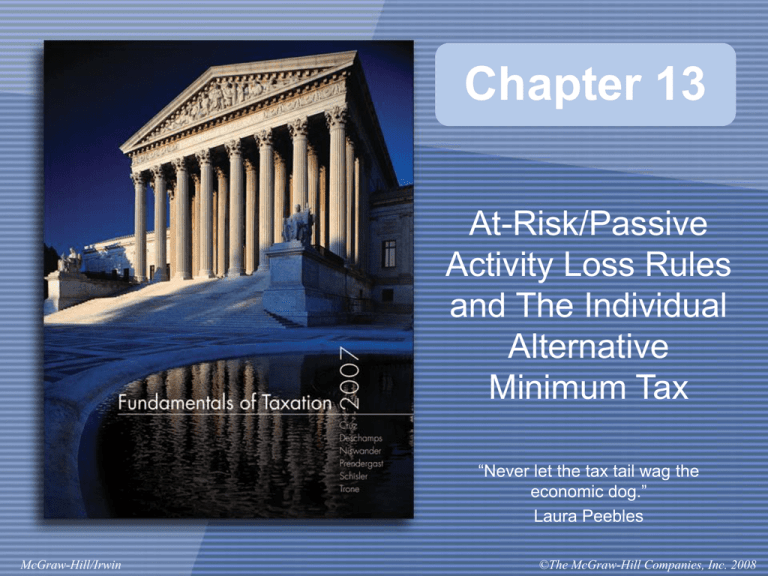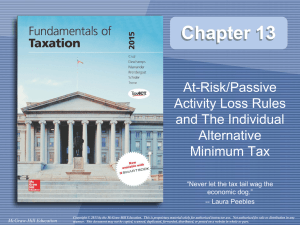the at-risk rules or the passive activity losses rules?
advertisement

Chapter 13 At-Risk/Passive Activity Loss Rules and The Individual Alternative Minimum Tax “Never let the tax tail wag the economic dog.” Laura Peebles McGraw-Hill/Irwin ©The McGraw-Hill Companies, Inc. 2008 LO #1- At-Risk Rules • At-risk activities include any “engaged…in carrying on a trade of business or for the production of income.” • Initial amount at-risk is any contribution of money plus the adjusted basis of contributed property. 13-2 LO #1- At-Risk Rules • What is “at-risk” or increases “atrisk” – Cash and property contributions – Share of liabilities – Income and gain items • What decreases “at-risk?” – Cash and property distributions – Release of liabilities 13-3 LO #1- At-Risk Rules • Form 6198 is filed for each activity subject to the at-risk limitation • Liabilities that affect at-risk amount – Recourse debt – Nonrecourse debt – Qualified nonrecourse debt 13-4 LO #1- At-Risk Rules • Losses disallowed under the at-risk rules – Carried over indefinitely – Deducted in years when the at-risk amount increases • Losses may still be subject to the passive loss limitations 13-5 LO #1- At Risk Rules Concept Check 1. Which of the following items will increase a taxpayer’s at-risk amount? a. A cash contribution made by the taxpayer into the activity. b. The taxpayer share of income from the activity. c. The taxpayer’s share of the activity’s liabilities for which the taxpayer is personally liable. d. All of the above. Answer: D 2. Which of the following type of liability does not increase the taxpayer’s atrisk in an activity? a. Non-recourse debt. b. Recourse debt. c. Qualified non-recourse debt. d. All of the above increase at risk. Answer: A 13-6 LO #1- At Risk Rules Concept Check 3. Which of the following is true when a loss is disallowed by the atrisk rules? a. The loss is lost forever. b. The loss can be used only at the activity’s disposal. c. The loss is indefinitely carried forward. d. The loss can be used only if the taxpayer makes a contribution to the activity. Answer: C 13-7 LO #2 – Passive Activities • What is a Passive Activity? – Taxpayer does not materially participate on a • Regular • Continuous • Substantial basis • Most rental activities and limited partnerships are passive by definition 13-8 LO #2 – Passive Activities • Seven tests for material participation – – – – > 500 hours All of the participation in the activity > 100 hours and not less than any other person > 100 hours and several activities that in aggregate exceed 500 hours – Material participant for any of the last five years – Material participant for any of last three years for personal service activity – Facts and circumstances 13-9 LO #2 – Passive Activities • Passive Losses – General Rule – Passive losses are allowed only to the extent of passive income • Income/loss items separated into three categories – Active Income/Loss – Portfolio Income – Passive Income/Loss • Passive cannot offset portfolio or active income 13-10 LO #2 – Passive Activities • Rental Activities – usually passive • Real estate professional exception • Six other instances where rental is not passive – – – – – Rental period less than seven days 30 day or less and significant personal services Extraordinary personal services Incidental to non-rental activity Customarily available during defined business hours – Rented to an entity the taxpayer owns 13-11 LO #2 – Passive Activities • $25,000 loss allowed for rental activities – Active participation – Own at least 10% of property • Starts to phase out when AGI reaches $100,000, not including the rental loss. • Eliminated when AGI exceeds $150,000 13-12 LO #2 – Passive Activities • Disposition of a passive activity in a taxable transaction. – Passive losses are allowed against nonpassive income – Suspended passive losses are permitted – Gifts and inheritance do not trigger use of suspended losses (does not meet taxable transaction criterion) 13-13 LO #2 – Passive Activities Concept Check 1. Rental properties are almost always considered passive activities. True 2. The general rule concerning the deductibility of passive losses is that they can be deducted only to the extent of passive income. True 13-14 LO #2 – Passive Activities Concept Check 3. For low income taxpayers, passive rental losses can be deducted against other income up to a maximum of $50,000. False 4. Generally, suspended passive losses can be deducted against other income when the activity is sold or disposed of. True or False True 13-15 LO #3 – At-Risk and PAL Rules In Conjunction • At-risk rules applied first then passive loss rules second. • Form 6198 for each at-risk activity • Form 8582 – one for all passive activities • PAL do not come into play unless the loss is first allowed under the at-risk rules 13-16 LO #3 - Concept Check 1. Which rules are applied first to a passive activity - the at-risk rules or the passive activity losses rules? Explain? In order for a loss to be deducted, it must first be allowed under the at-risk rules. Once the loss is allowed under the at-risk rules, the passive loss rules are applied. 2. Why must suspended passive losses from several passive activities be allocated among the activities? The main reason is that passive losses are allowed when an activity is sold or disposed of. Thus, if a taxpayer were considering the sale of a passive activity, he or she could lump all suspended passive losses on one activity and sell it. All of the losses would then be allowed. The allocation to all loss activities stops this potential abuse. 13-17 LO #3 - Concept Check 3. If a taxpayer has AGI of $105,000 before considering a $23,000 loss from a rental activity, how much can the taxpayer deduct from the rental activity, if any? The taxpayer is eligible for the $25,000 offset for rental losses. However, the $25,000 limit is phased out once the taxpayer’s AGI reaches $100,000 [($105,000 - $100,000) × ½ = $2,500]. Thus, only $22,500 of the rental loss would be allowed. 13-18 LO #4 – Alternative Minimum Tax (AMT) • AMT Formula – – – – – – – – Regular taxable income Plus exemptions and standard deduction Plus/minus adjustment items Plus tax preference items Minus AMT exemption amount Multiplied by 26% or 28% less $3,500 Tentative AMT less regular tax Equals AMT 13-19 LO #4 – Alternative Minimum Tax (AMT) • Adjustments – limits on itemized deductions – Medical – AGI floor increased to 10% – Taxes – not allowed for AMT – Mortgage interest – must be to build, buy, or improve residence – Charity – no adjustment – Casualty and theft – no adjustment – Miscellaneous – not allowed for AMT 13-20 LO #4 – Alternative Minimum Tax (AMT) • Depreciation adjustments – Real property 1986 – 1999 – 40 years life of all real property for AMT – Real property after 1998 – no AMT adjustment – Personal property 1986 -1998 – longer life and method change to 150% declining balance – Personal property after 1998 – method change to 150% declining balance for AMT 13-21 LO #4 – Alternative Minimum Tax (AMT) • Other adjustments – Basis calculation for gains and losses – Incentive stock options adjustment – Adjustments from K-1s – Long-term contracts • Tax preference items – not much of an issue any longer 13-22 LO #4 – Alternative Minimum Tax (AMT) • Exemption amount – Single – MFJ – MFS $42,500 $62,550 $31,275 • Phase-out – exemption is reduced by 25% of AMTI in excess of income limits – $112,500 single, $150,000 MFJ, $75,000 MFS 13-23 LO #4 – AMT Concept Check 1. Medical expenses are allowed in full (same as the regular tax) for AMT purposes. False 2. No taxes are allowed as a deduction for AMT purposes. True 13-24 LO #4 – AMT Concept Check 3. If a taxpayer is married and has eight children, his personal exemptions for regular tax purposes could be $33,000 (10 exemptions × $3,300) depending on his AGI. None of this amount would be allowed for AMT purposes. True 4. If a taxpayer’s AMTI was under $175,000, the AMT tax rate would be 26%. True or False True 13-25






